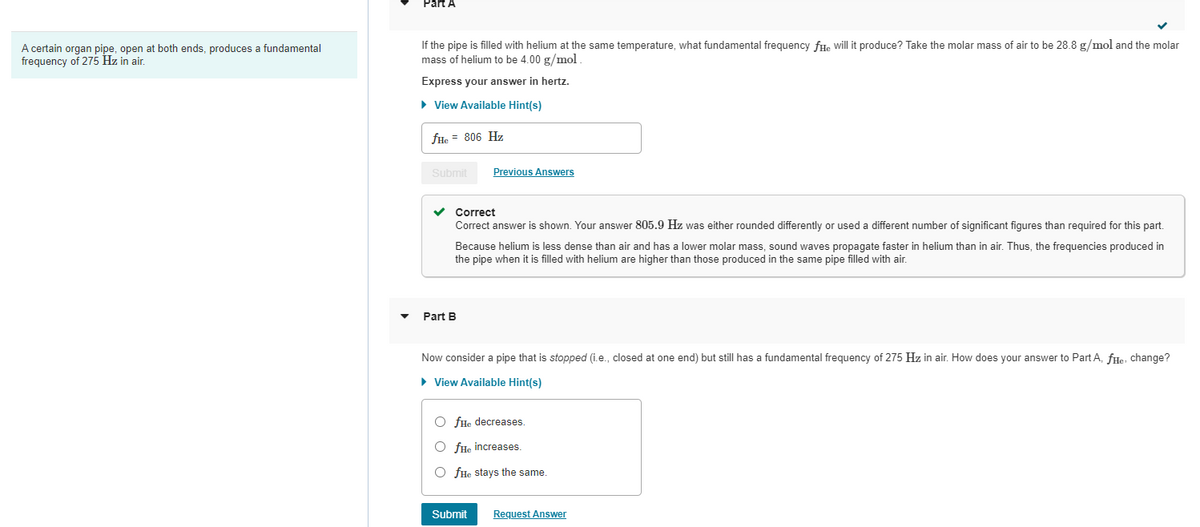A certain organ pipe, open at both ends, produces a fundamental frequency of 275 Hz in air. If the pipe is filled with helium at the same temperature, what fundamental frequency file will it produce? Take the molar mass of air to be 28.8 g/mol and the molar mass of helium to be 4.00 g/mol. Express your answer in hertz. ▸ View Available Hint(s) file = 806 Hz Submit Previous Answers ✓ Correct Correct answer is shown. Your answer 805.9 Hz was either rounded differently or used a different number of significant figures than required for this part. helium than in air. Thus, the frequencies produced in Because helium sless dense than air and has a lower molar mass, sound waves propagate faster the pipe when it is filled with helium are higher than those produced in the same pipe filled with air. Part B Now consider a pipe that is stopped (i.e., closed at one end) but still has a fundamental frequency of 275 Hz in air. How does your answer to Part A. fe. change? ► View Available Hint(s) OfHe decreases. O file increases. OfHe stays the same. Submit Request Answer
A certain organ pipe, open at both ends, produces a fundamental frequency of 275 Hz in air. If the pipe is filled with helium at the same temperature, what fundamental frequency file will it produce? Take the molar mass of air to be 28.8 g/mol and the molar mass of helium to be 4.00 g/mol. Express your answer in hertz. ▸ View Available Hint(s) file = 806 Hz Submit Previous Answers ✓ Correct Correct answer is shown. Your answer 805.9 Hz was either rounded differently or used a different number of significant figures than required for this part. helium than in air. Thus, the frequencies produced in Because helium sless dense than air and has a lower molar mass, sound waves propagate faster the pipe when it is filled with helium are higher than those produced in the same pipe filled with air. Part B Now consider a pipe that is stopped (i.e., closed at one end) but still has a fundamental frequency of 275 Hz in air. How does your answer to Part A. fe. change? ► View Available Hint(s) OfHe decreases. O file increases. OfHe stays the same. Submit Request Answer
University Physics Volume 1
18th Edition
ISBN:9781938168277
Author:William Moebs, Samuel J. Ling, Jeff Sanny
Publisher:William Moebs, Samuel J. Ling, Jeff Sanny
Chapter17: Sound
Section: Chapter Questions
Problem 82P: A crude approximation of voice production is to consider the breathing passages and mouth to be a...
Related questions
Concept explainers
Interference of sound
Seiche
A seiche is an oscillating standing wave in a body of water. The term seiche pronounced saysh) can be understood by the sloshing of water back and forth in a swimming pool. The same phenomenon happens on a much larger scale in vast bodies of water including bays and lakes. A seizure can happen in any enclosed or semi-enclosed body of water.
Question

Transcribed Image Text:A certain organ pipe, open at both ends, produces a fundamental
frequency of 275 Hz in air.
Part A
If the pipe is filled with helium at the same temperature, what fundamental frequency fHe will it produce? Take the molar mass of air to be 28.8 g/mol and the molar
mass of helium to be 4.00 g/mol.
Express your answer in hertz.
► View Available Hint(s)
fHe = 806 Hz
Submit
Previous Answers
Correct
Correct answer is shown. Your answer 805.9 Hz was either rounded differently or used a different number of significant figures than required for this part.
Because helium is less dense than air and has a lower molar mass, sound waves propagate faster in helium than in air. Thus, the frequencies produced in
the pipe when it is filled with helium are higher than those produced in the same pipe filled with air.
Part B
Now consider a pipe that is stopped (i.e., closed at one end) but still has a fundamental frequency of 275 Hz in air. How does your answer to Part A, ƒHe, change?
► View Available Hint(s)
OfHe decreases.
fHe increases.
OfHe stays the same.
Submit Request Answer
Expert Solution
This question has been solved!
Explore an expertly crafted, step-by-step solution for a thorough understanding of key concepts.
This is a popular solution!
Trending now
This is a popular solution!
Step by step
Solved in 3 steps with 3 images

Knowledge Booster
Learn more about
Need a deep-dive on the concept behind this application? Look no further. Learn more about this topic, physics and related others by exploring similar questions and additional content below.Recommended textbooks for you

University Physics Volume 1
Physics
ISBN:
9781938168277
Author:
William Moebs, Samuel J. Ling, Jeff Sanny
Publisher:
OpenStax - Rice University

University Physics Volume 1
Physics
ISBN:
9781938168277
Author:
William Moebs, Samuel J. Ling, Jeff Sanny
Publisher:
OpenStax - Rice University